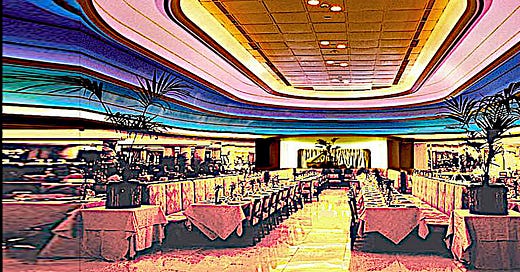In London until September, at the Fashion & Textile Museum in Bermondsey, there’s an exhibition of fashions created by Biba. Sometimes, a place becomes so associated with the music industry of its time that it seems like a part of it. In late 1970s New York, it was Studio 54. In early 1970s London, it was Biba.
It was the brain child of Barbara Hulanicki who in the 1960s ran a small fashion shop in Abingdon Road, Kensington, where pop stars liked to shop on Saturdays. It was jammed week in, week out. So much so, that somehow, in the early 70s, Barbara and her husband got hold of enough money to buy a lease on Derry and Tom’s on Kensington High Street, amongst the poshest and biggest department stores in London, which they turned into an art deco palace - a paean to glam rock decadence.
Within weeks of its opening Biba had become as important a venue on the tourist A-list as Buckingham Palace or Harrods. The decor was amazing but the products less so. Hulanicki explained, "I didn't want to make clothes for kept women, I wanted to make clothes for people in the street.” So she tried to keep prices down to the bare minimum.
People complained that some of the dresses were itchy and uncomfortable and stopped women from bending their arms. The Financial Times foresaw problems from the very first day, noting that “less than fifty per cent of the overall floor space" was being used to sell the company’s products. Never mind - the place looked amazing.
Within a month, a million people a week were turning up to gawp at it. They found themselves welcomed into a department store that encouraged people to hang out even if they didn’t buy anything. It was glamour beyond belief. There was a food hall inspired by Andy Warhol’s soup-can paintings. And a ground floor dedicated to fashion and make-up, where customers could not only try on the clothes but try out the make-up too.
There was also a roof garden that became London’s number one spot for top photographers to snap glamourous people. Not just a couple of flower beds; it was one and a half acres of full-size trees, fish ponds, bridges, walkways, shrubs, sitting areas and a gazebo. It cost nothing to walk around for as long you wanted but required a permanent team of gardeners to keep it up.
The pièce de résistance was the Rainbow Room on the fifth floor, a restaurant where the cost of the black lacquered china alone guaranteed there would never be a profit. It seated 400 people, was open day and night, and its art deco ceiling moved with endless permutations of coloured lights. If you went there for dinner, you could find yourself sitting next to Barbra Streisand or being entertained by the Pointer Sisters. One evening, mid-meal, the doors opened and Liberace floated in decked out in white mink and diamond buttons.
If you popped in round midnight for some caviar amongst the pink-marble, there might well be a party going on that included Andy Warhol, Elizabeth Taylor, Lord Snowdon or Princess Margaret. Or the current aristocrats of British pop, Marc Bolan, or Elton John, or David Bowie. All great fun. But too often, at 1am there’d be just three or four tables out of a hundred occupied, with the full kitchen and waiting staff being paid till 2.30 in the morning.
Biba was a temple to the art of going bankrupt. It lasted just 22 months and how Hulanicki had ever found backers crazy enough to put money into it was beyond explanation. Commerce just wasn’t in her thinking. Biba’s became a watering hole for celebrities, and everyone else came and cashed in on it.
Like so many other people I had many magic moments there – amazing dinners, caviar lunches, midnight parties and musical events. Of all of them, perhaps the most memorable was a shambolic New Year’s Eve party in 1974. Less than two years after it opened, the store was already on the verge of bankruptcy. Most people didn’t know, but Hulanicki was all too aware of it….
“Every time I went into the shop,” she said. “I was afraid it would be for the last time.”
So she cheered herself up by planning a New Year’s bash that no one would forget. Mainly because everything went wrong….
“As the bells sounded we released the net full of balloons. Somehow we hadn’t got it quite right; the balloons came down all right, but when the waiters in charge tried to raise the net several customers had become attached to it and were dangling above the heads of the crowd, who grandly ignored them. We released the net and let the hanging guests crash back into the crowd.”
Among those who fell unglamorously to earth were the painter Patrick Hughes - Tony Elliot, the publisher of Time Out - TV presenter, Janet Street-Porter - and Michael Roberts, the fashion editor of the Sunday Times, who was dressed as Diana Ross.
Early in the New Year, Biba itself crashed to earth.
CLICK AND LEAVE YOUR EMAIL. IT’S FREE. RECEIVE REGULAR UPDATES.





Mum took me to Biba right before it closed. My brothers couldn't care less, but this boy was in heaven - a sad heaven to be sure, because it was closing, but we walked out in a flurry of fabulous scarves.
Thank you, what a mad time, and a good explanation of what really went on! I had not realised the extent of it!